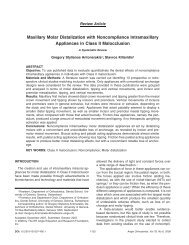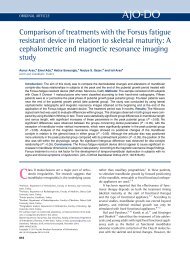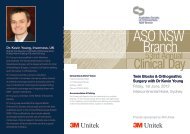As
Efficiency of a skeletonized distal jet appliance supported by ...
Efficiency of a skeletonized distal jet appliance supported by ...
You also want an ePaper? Increase the reach of your titles
YUMPU automatically turns print PDFs into web optimized ePapers that Google loves.
American Journal of Orthodontics and Dentofacial Orthopedics Kinzinger et al 583<br />
Volume 136, Number 4<br />
Table III. Dental angular and linear measurements<br />
Cephalometric analysis n T1 mean T1 SD T2 M T2 SD D T1-T2 M D T1-T2 SD Significance<br />
Dental-angular<br />
U1/AN-PNS ( ) 10 107.93 4.80 108.50 4.94 –0.57 0.79 NS<br />
U1/SN ( ) 10 101.86 5.28 102.50 5.45 –0.64 0.75 NS<br />
U4/AN-PNS ( ) 10 91.86 6.01 90.71 6.11 1.15 2.98 NS<br />
U4/SN ( ) 10 85.86 7.61 85.07 7.37 0.79 2.23 NS<br />
U5/ANS-PNS ( ) 10 82.29 4.71 79.29 5.62 3.00 2.69 *<br />
U5/SN ( ) 10 76.50 5.37 73.29 5.26 3.21 2.86 *<br />
U6/ANS-PNS ( ) 10 75.36 3.82 72.57 4.04 2.79 2.51 *<br />
U6/SN ( ) 10 69.71 4.79 66.71 4.35 3.00 2.31 *<br />
Dental-linear<br />
U1-CEJ/PTV (mm) 10 52.54 2.94 52.90 2.98 –0.36 0.32 *<br />
U4-CEJ/PTV (mm) 10 38.47 3.37 39.19 3.78 –0.72 0.78 *<br />
U5-CEJ/PTV (mm) 10 31.21 3.11 29.34 3.00 1.87 0.74<br />
†<br />
U6-CEJ/PTV (mm) 10 22.59 3.31 18.67 3.11 3.92 0.53<br />
‡<br />
U1-CEJ/ANS-PNS (mm) 10 17.96 2.62 18.10 2.44 –0.14 0.29 NS<br />
U4-CEJ/ANS-PNS (mm) 10 15.79 1.53 15.93 1.55 –0.14 0.14 *<br />
U5-CEJ/ANS-PNS (mm) 10 14.59 2.06 15.01 1.97 –0.42 0.41 *<br />
U6-CEJ/ANS-PNS (mm) 10 13.16 1.78 13.00 1.65 0.16 0.26 NS<br />
*P \0.05; † P \0.01; ‡ P \0.001; NS, not significant.<br />
Table IV. Proportion of maxillary molar distalization in<br />
total movement in the sagittal plane<br />
Cephalometric analysis n D T1-T2 mean D T1-T2 SD<br />
Dental-linear (mm)<br />
U1-CEJ/PTV (mm) 10 –0.36 0.32<br />
U4-CEJ/PTV (mm) 10 –0.72 0.78<br />
U6-CEJ/PTV (mm) 10 3.92 0.53<br />
Total sagittal movement 1-6* 10 4.28 0.51<br />
Total sagittal movement 4-6 † 10 4.64 1.06<br />
Calculation of ratio (%)<br />
Proportion of molar 10 91.71 7.32<br />
sagittal movement 1-6 ‡<br />
distalization in total<br />
Proportion of molar<br />
distalization in total<br />
sagittal movement 4-6 § 10 86.56 13.21<br />
*Total movement in the sagittal plane 1-6 5 [U1-CEJ/PTV] 1 [U6-<br />
CEJ/PTV]; † Total movement in the sagittal plane 4-6 5 [U4-CEJ/<br />
PTV] 1 [U6-CEJ/PTV]; ‡ Calculation: proportion of molar distalization<br />
in total sagittal movement 1-6 5 100 3 (U6-CEJ/PTV)/([U1-<br />
CEJ/PTV] 1 [U6-CEJ/PTV]); § Calculation: proportion of molar distalization<br />
in total sagittal movement 4-6 5 100 3 (U6-CEJ/PTV)/<br />
([U4-CEJ/PTV] 1 [U6-CEJ/PTV]).<br />
should be derotated with an appropriate appliance, such<br />
as a transpalatal bar or a bi-helix.<br />
We found, during lateral cephalograph analysis, unlike<br />
the results of the in-vitro analysis, that the permanent<br />
first molars experienced slight dental crown<br />
tipping in the sagittal plane rather than root uprighting. 4<br />
The cause of this might be that the patients’ palatal<br />
vaults were not deep enough to enable placement of<br />
the loaded coil systems at the level of the center of resistance<br />
of the molars. Also, the location of the center of<br />
resistance can be determined only by approximation.<br />
Moreover, the respective development stages of the second<br />
molars might influence the extent of distal tipping<br />
of the first molars. In most patients in this study, the second<br />
molars were germinating or erupting. In a clinical<br />
study with pendulum appliances, Kinzinger et al 8<br />
showed that the extent of distal tipping is relatively<br />
greater when the second molars are only germinating.<br />
This phenomenon can be explained as follows: a germinating<br />
second molar has the same effect as a lever pivot<br />
point on the permanent first molar to be distalized; the<br />
first molar, when reacting to distalization, tips over the<br />
second molar germ. <strong>As</strong> its root is developing and the<br />
permanent second molar is erupting, the point of contact<br />
between the 2 molars gradually moves coronally. The<br />
tendency for the first molar to tip thereby decreases.<br />
Conventionally, the anchorage setup of exclusively<br />
intraorally anchored appliances for noncompliance molar<br />
distalization combines an acrylic button on the palatal<br />
mucosa with using the periodontium of anchorage<br />
teeth. The disadvantages of this kind of anchorage include,<br />
in particular, restrictions to hygiene 5 and contraindications<br />
based on certain dentition stages and local<br />
situations. 7 Moreover, it must be discussed how far<br />
the anchorage effect of an anteriorly placed Nance<br />
button potentially relies only on hydrodynamic interactions<br />
due to the resilient mucosa. Thereby it would be<br />
a disqualifying design for stationary anchorage designs,<br />
and hence must not be overestimated in terms of anchorage<br />
quality. 5






